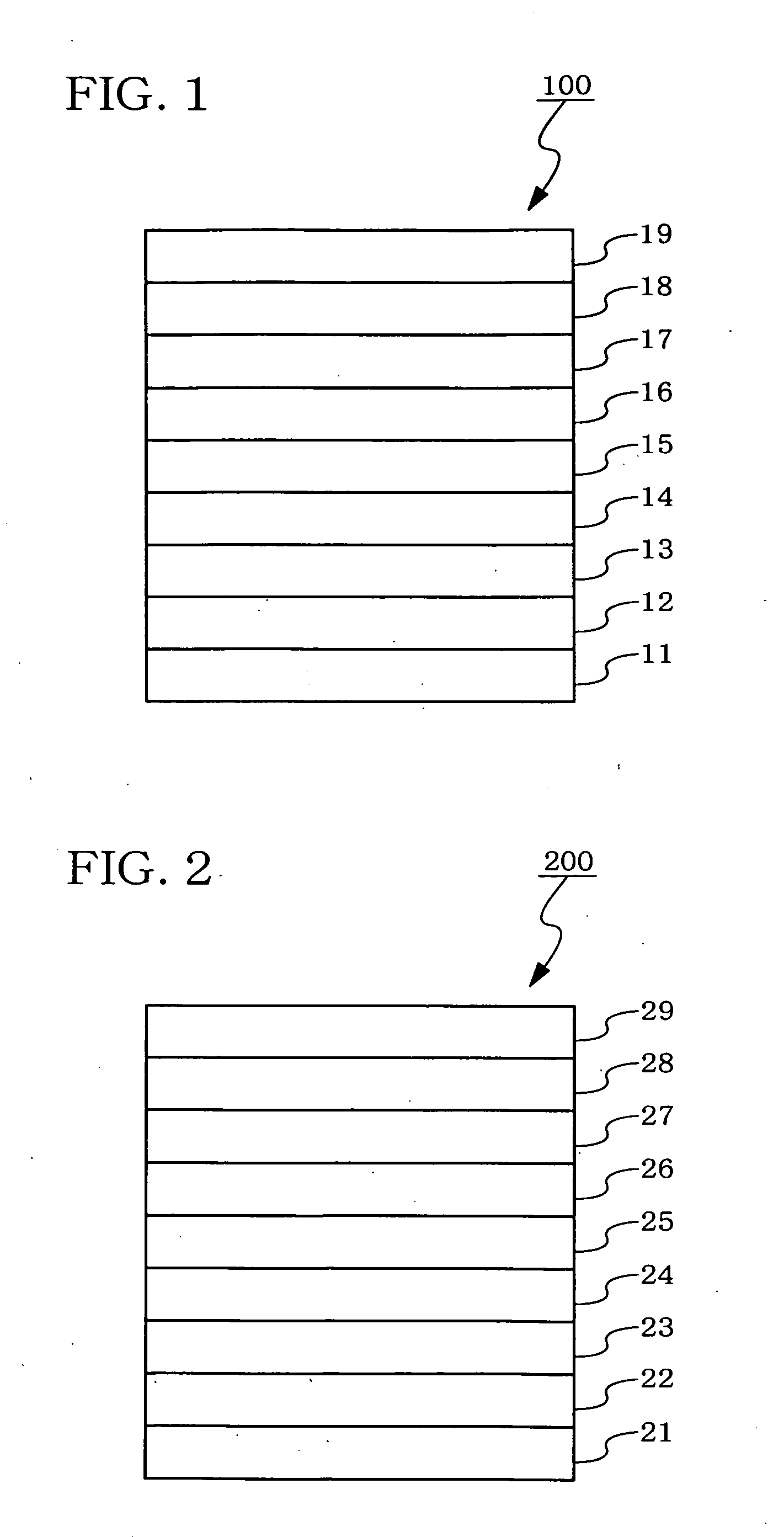Organic electroluminescent device
a technology of electroluminescent devices and electroluminescent tubes, which is applied in the direction of discharge tube luminescent screens, natural mineral layered products, transportation and packaging, etc., can solve the problems of difficult to reduce the power consumption of flat panel displays, significant reduction of emission efficiency, etc., and achieve high current efficiency and high luminous efficiency
- Summary
- Abstract
- Description
- Claims
- Application Information
AI Technical Summary
Benefits of technology
Problems solved by technology
Method used
Image
Examples
example 1
[0083] An organic EL device shown in FIG. 1 was fabricated as follows.
[0084] A glass substrate 11, measuring 25 mm×75 mm×1.1 mm thick, with an ITO transparent electrode (anode) 12 (manufactured by Geomatics Co.) was subjected to ultrasonic cleaning in isopropyl alcohol for 5 minutes and then to UV ozone cleaning for 30 minutes. The cleaned glass substrate 11 with transparent electrode lines was mounted on a substrate holder in a vacuum deposition device. First, a 100 nm thick film of N,N′-bis(N,N′-diphenyl-4-aminophenyl)-N,N-diphenyl-4,4′-diamino-1,1′-biphenyl (hereinafter referred to as TPD 232 film) 13 was formed by resistance heating deposition on the surface where the transparent electrode lines were formed, so as to cover the transparent electrode 12. This TPD 232 film 13 functioned as a hole-injecting layer (a hole-transporting layer).
[0085] After the formation of the TPD 232 film 13, a 10 nm thick hole-transporting layer (hereinafter referred to as HTM) 14 was formed by res...
example 2
[0089] An organic EL device was fabricated in the same manner as in Example 1 except that the following PC-8 was introduced by resistance heating deposition to a thickness of 30 nm as an electron-transporting layer on an emitting layer made of the host material 2: FIrpic.
example 3
[0090] An organic EL device shown in FIG. 2 was fabricated as follows.
[0091] A glass substrate 21, measuring 25 mm×75 mm×1.1 mm thick, with an ITO transparent electrode (anode) 22 (manufactured by Geomatics Co.) was subjected to ultrasonic cleaning in isopropyl alcohol for 5 minutes and then to UV ozone cleaning for 30 minutes. The cleaned glass substrate 21 with transparent electrode lines was mounted on a substrate holder in a vacuum deposition device. First, a 100 nm thick TPD 232 film 23 was formed by resistance heating deposition on the surface where the transparent electrode lines were formed, so as to cover the transparent electrode 22. The TPD 232 film 23 functioned as a hole-injecting (hole-transporting) layer.
[0092] After the formation of the TPD 232 film 23, a 10 nm thick hole-transporting layer (HTM) 24 was formed by resistance heating deposition. After the formation of the hole-transporting layer 24, a host material 1 and FIrpic were co-deposited by resistance heating...
PUM
| Property | Measurement | Unit |
|---|---|---|
| triplet energy gap | aaaaa | aaaaa |
| triplet energy gap | aaaaa | aaaaa |
| ionization potential | aaaaa | aaaaa |
Abstract
Description
Claims
Application Information
 Login to View More
Login to View More - R&D
- Intellectual Property
- Life Sciences
- Materials
- Tech Scout
- Unparalleled Data Quality
- Higher Quality Content
- 60% Fewer Hallucinations
Browse by: Latest US Patents, China's latest patents, Technical Efficacy Thesaurus, Application Domain, Technology Topic, Popular Technical Reports.
© 2025 PatSnap. All rights reserved.Legal|Privacy policy|Modern Slavery Act Transparency Statement|Sitemap|About US| Contact US: help@patsnap.com



